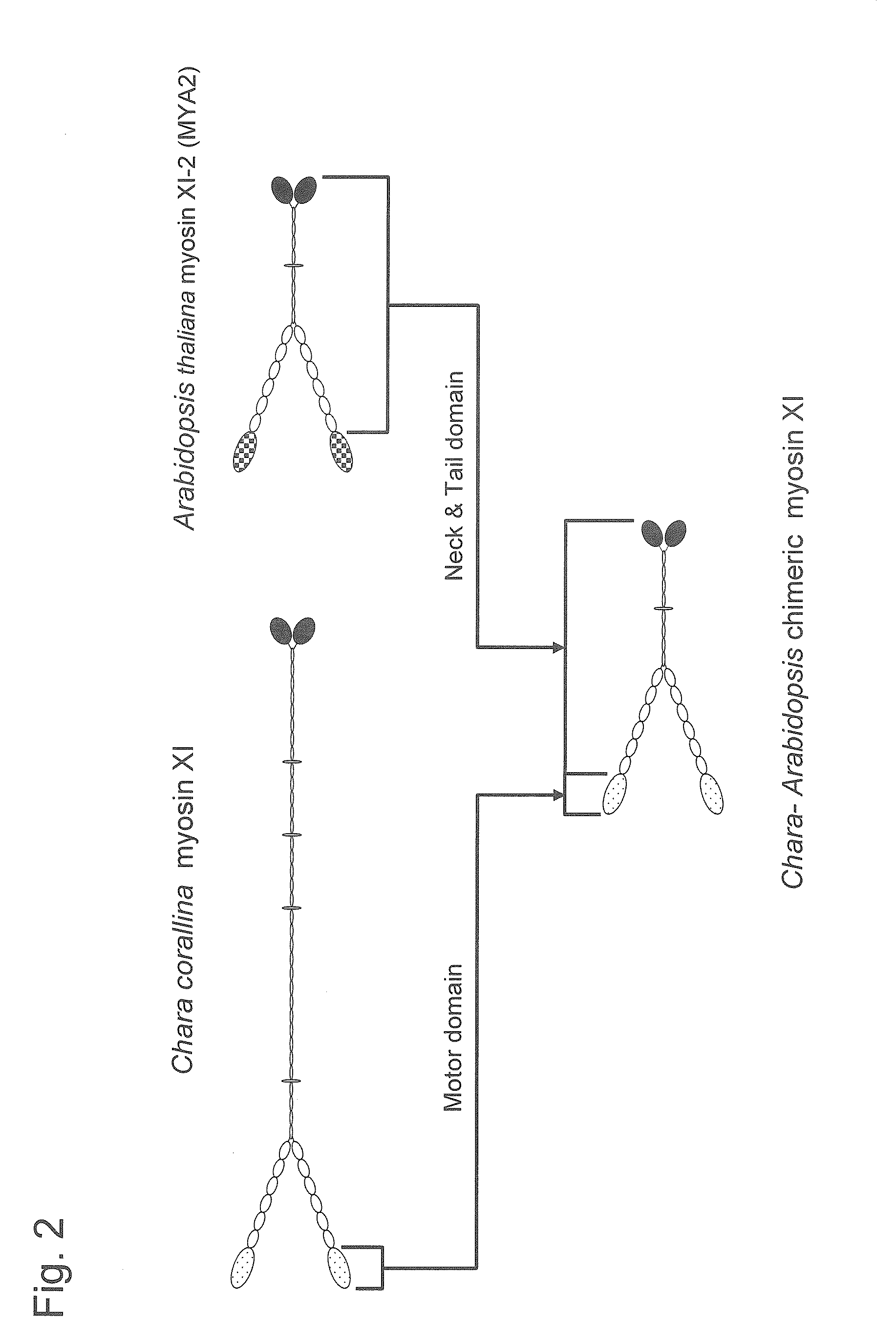Plant with enhanced growth and method for producing the same
a technology of enhanced growth and plant, which is applied in the field of plant with enhanced growth and a method for producing the same, can solve the problems that the functions of individual myosin xi proteins have not been elucidated, and achieve the effects of increasing the biomass of a plant, enhancing growth, and increasing growth
- Summary
- Abstract
- Description
- Claims
- Application Information
AI Technical Summary
Benefits of technology
Problems solved by technology
Method used
Image
Examples
example 1
Construction of the Chimeric Myosin XI Gene
[0163]The chimeric myosin XI gene used in the present invention was designed and constructed in the manner described below.
(Method)
[0164]1. Cloning of the A. thaliana XI-2 (MYA2) Gene
[0165]Total RNA was prepared from an A. thaliana plant on day 7 after sowing. Total RNA was prepared using an RNeasy Plant Mini Kit (QIAGEN) according to the manufacturer's protocol. First-strand cDNA was prepared using a SuperScript III First-Strand Synthesis System for RT-PCR (Invitrogen) according to the manufacturer's protocol. Next, the MYA2 gene was amplified by RT-PCR using total RNA prepared above. PCR was performed using the oligonucleotide shown in SEQ ID NO: 23 as a forward primer and the oligonucleotide shown in SEQ ID NO: 24 as a reverse primer under reaction conditions comprising 35 cycles of 98° C. for 10 seconds, 60° C. for 30 seconds, and 72° C. for 3.5 minutes. The amplified products were inserted into a pENTR-D-TOPO cloning vector included in...
example 2
[0170]The chimera XI gene constructed in Example 1 and the wild-type MYA2 gene were expressed in vitro for verification of the velocity of movement of each myosin molecule.
(Method)
[0171]The Flag-chimera XI gene and the Flag-MYA2 XI gene prepared in Example 1 were expressed by a known method using a baculovirus-insect cell system. Subsequently, a Flag-chimera XI protein was purified using an anti-FLAG M2 affinity resin (Sigma).
[0172]The velocity was determined for each myosin molecule by an antibody-based version of in vitro sliding filament assay using an anti-C-mic monoclonal antibody (Zymed Laboratories Inc.; Cat. No. 13-2500), except that, unlike conventional in vitro sliding filament assay, exogenous calmodulin (approximately 1 μM) was added to an assay buffer during the assay in this Example. The average sliding velocity of the myosin molecule was calculated by determining displacement of actin filament that smoothly moves over a distance more than 10 μm....
example 3
Verification of the Phenotype of a Transgenic Plant (1)
[0174]The phenotype of A. thaliana transformed with the chimeric myosin XI gene constructed in Example 1 was compared with the phenotype of A. thaliana transformed with the wild-type MYA2 gene for verification.
1. Plant Transformation
[0175]The GFP-chimera XI gene constructed in Example 1 was introduced into a XI-2 gene-knockout A. thaliana (SALK 055785; At5g43900) strain (designated as the “MYA2-KO strain”) (provided by Dr. Dolja of Oregon State University, USA) by a floral dipping method. As a control, the sGFP-MYA2 gene was constructed by connecting the sGFP gene to the 5′ end of the wild-type MYA2 gene. Specifically, ProXI-2:sGFP:MYA-2 connected downstream of the MYA2 gene promoter was constructed by Triple Template-PCR (TT-PCR) and subcloned using a pENTR-D-TOPO cloning vector. Then, pGWB501 (Nakagawa et al., 2007, Biosci. Biotechnol. Biochem. 71: 2095-2100) was introduced into the MYA2-del strain via an LR reaction in a simi...
PUM
| Property | Measurement | Unit |
|---|---|---|
| Fraction | aaaaa | aaaaa |
| Length | aaaaa | aaaaa |
| Length | aaaaa | aaaaa |
Abstract
Description
Claims
Application Information
 Login to View More
Login to View More - R&D
- Intellectual Property
- Life Sciences
- Materials
- Tech Scout
- Unparalleled Data Quality
- Higher Quality Content
- 60% Fewer Hallucinations
Browse by: Latest US Patents, China's latest patents, Technical Efficacy Thesaurus, Application Domain, Technology Topic, Popular Technical Reports.
© 2025 PatSnap. All rights reserved.Legal|Privacy policy|Modern Slavery Act Transparency Statement|Sitemap|About US| Contact US: help@patsnap.com



